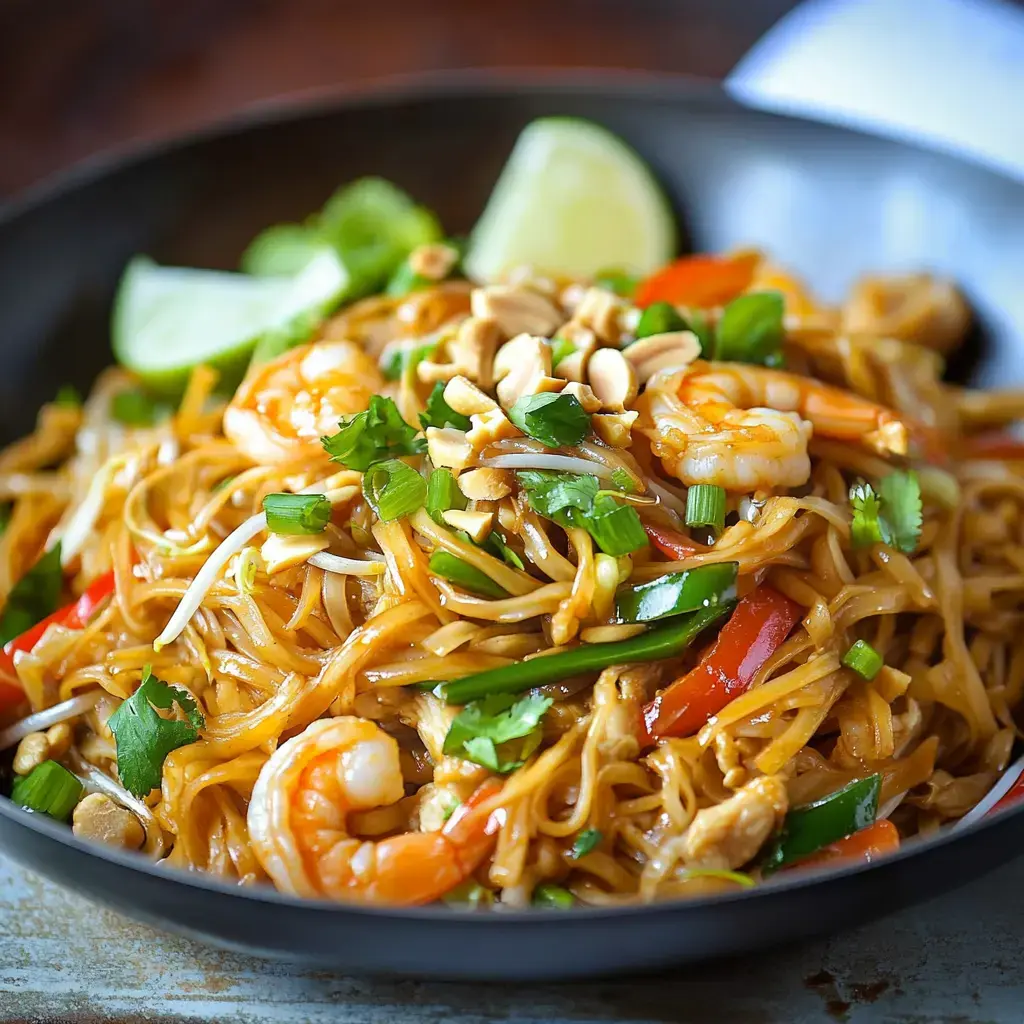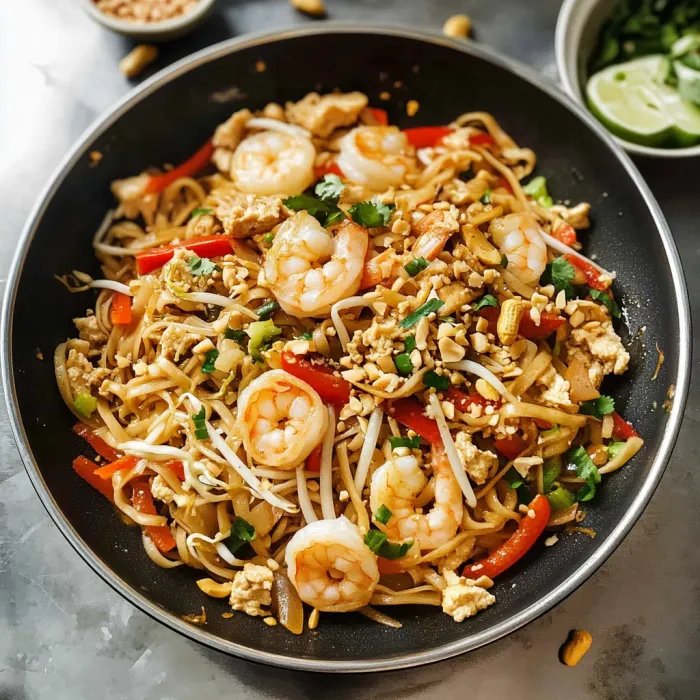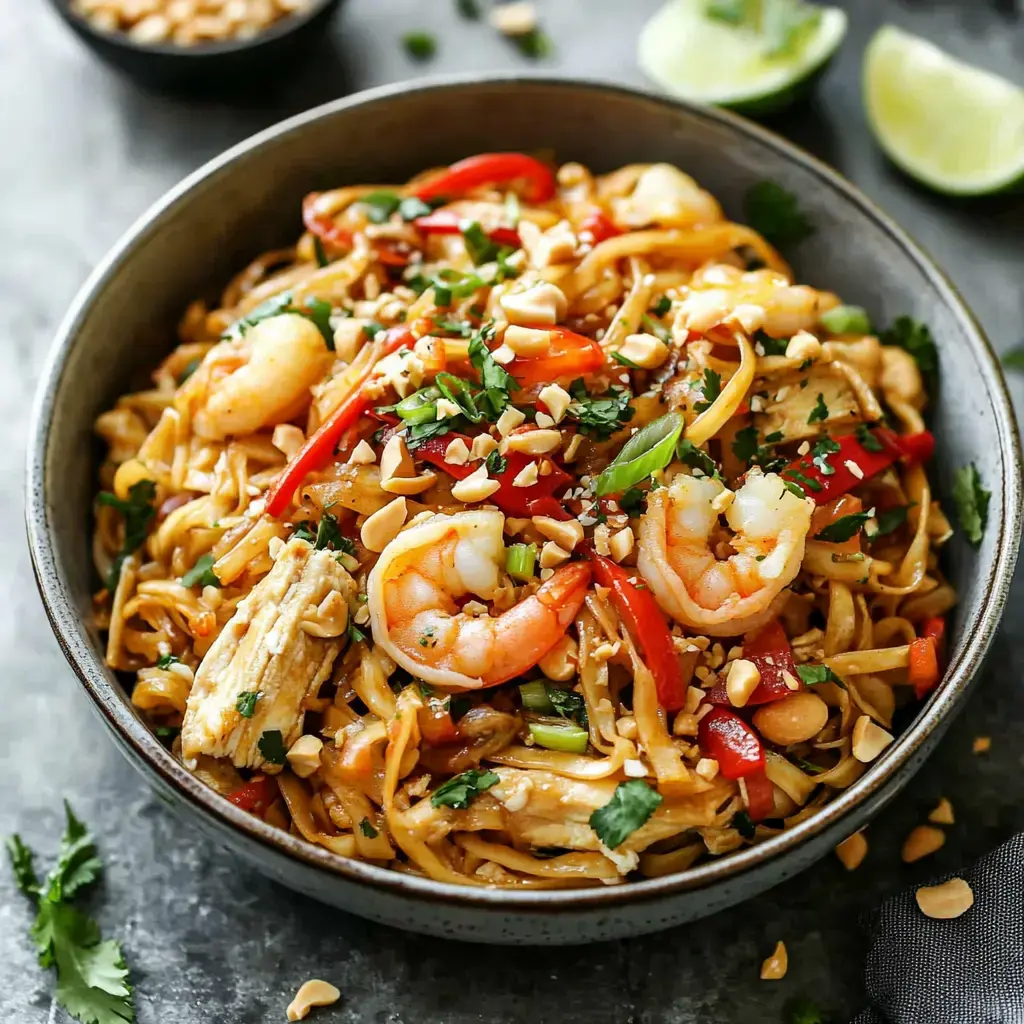 Pin
Pin
This vibrant Pad Thai has been my go-to weeknight dinner for years, delivering authentic Thai flavors with minimal fuss. The combination of tender rice noodles, savory protein, and the perfect balance of sweet, sour, and umami flavors creates a restaurant-quality dish right in your home kitchen.
I first discovered this recipe during a cooking class in Bangkok, and it has become my dinner party signature dish. Even my pickiest friends request it whenever they visit, and it never fails to transport us all to the bustling street markets of Thailand.
Ingredients
- Rice noodles: Form the foundation of this dish look for flat rice stick noodles labeled as Pad Thai or Banh Pho
- Protein options: Including shrimp chicken or tofu make this versatile choose the freshest available
- Fish sauce: Provides essential umami depth Red Boat brand offers the purest flavor
- Brown sugar: Balances the sour and salty elements with necessary sweetness
- Tamarind paste or rice vinegar: Delivers the signature tanginess authentic versions use tamarind
- Fresh lime: Brightens the entire dish providing essential acidity
- Bean sprouts: Add essential crunch and freshness
- Peanuts: Contribute texture and nutty flavor toast them lightly for enhanced taste
- Cilantro: Offers a fresh herbaceous finish choose bunches with vibrant green leaves
How To Make Pad Thai
- Prepare The Noodles:
- Soak rice noodles according to package directions until just al dente about 8 minutes in hot water. The key is to slightly undercook them as they will continue softening in the wok. Rinse immediately under cold water to stop the cooking process and prevent sticking. This step can be done up to an hour ahead.
- Create The Sauce:
- Whisk together fish sauce, soy sauce, brown sugar, tamarind paste or rice vinegar, Sriracha, and optional peanut butter until sugar completely dissolves. The sauce should taste balanced with sweet, sour, salty, and spicy notes. This perfect harmony is essential to authentic Pad Thai flavor.
- Cook The Protein:
- Heat oil in a large wok or skillet over mediumhigh heat until shimmering. Add minced garlic and cook for 30 seconds until fragrant. Add your protein of choice, cooking shrimp until pink and opaque about 2 minutes per side, chicken until no longer pink about 3 minutes, or tofu until golden about 2 minutes per side. The high heat ensures caramelization without overcooking.
- Add The Eggs:
- Push cooked ingredients to one side of the pan and add beaten eggs to the empty space. Let them set slightly before gently scrambling. The eggs should remain soft and just set, creating silky pockets throughout the dish.
- Combine Everything:
- Add the prepared noodles to the wok and pour the sauce overtop. Toss constantly using two spatulas to ensure even coating. Add bean sprouts and most of the peanuts, reserving some for garnish. Continue tossing for 1 to 2 minutes until noodles absorb the sauce and everything is well combined. The noodles should be tender but still have a slight chew.
- Garnish And Serve:
- Transfer to serving plates and top with green onions, reserved peanuts, cilantro, and lime wedges. Squeezing fresh lime juice right before eating awakens all the flavors and brings the dish together.

My favorite part about this recipe is the tamarind paste, which gives Pad Thai its distinctive tangy flavor. I once tried to substitute lemon juice in a pinch, and while the dish was good, it lacked that special something that makes Pad Thai truly authentic. Now I always keep tamarind paste in my pantry as an essential Thai cooking ingredient.
Storage Tips
Pad Thai is best enjoyed immediately after cooking, but leftovers can be stored in an airtight container in the refrigerator for up to 3 days. When reheating, add a splash of water and a drizzle of oil to prevent the noodles from drying out. Reheat in a skillet over medium heat rather than microwave for best texture. Unfortunately, Pad Thai does not freeze well as the noodles become mushy upon thawing.
Ingredient Substitutions
If you cannot find rice noodles, linguine can work in a pinch, though the texture will differ. For a vegetarian version, replace fish sauce with a mix of soy sauce and a touch of mushroom powder for umami depth. No tamarind paste? While not identical, a mixture of lime juice and brown sugar creates a similar sweet-sour profile. Allergic to peanuts? Substitute toasted sunflower seeds or cashews for crunch.
Authentic Thai Touches
Traditional Pad Thai in Thailand often includes dried shrimp, preserved radish, and tamarind pulp rather than paste. Street vendors cook one portion at a time over intense heat, which is why homemade versions sometimes lack the characteristic "wok hei" or breath of the wok. To approximate this flavor at home, use the hottest setting on your stove and work in batches if preparing for more than two people. Also, authentic Pad Thai is not overly saucy but rather has noodles that are individually coated with flavor.

Recipe FAQs
- → How do I prepare the noodles for Pad Thai?
Cook flat rice noodles according to package instructions until just tender, then rinse them under cold water to stop cooking. Set aside until ready to stir-fry.
- → Can I make Pad Thai vegetarian?
Yes, you can replace shrimp or chicken with tofu and omit the eggs. Also, substitute fish sauce with extra soy sauce or tamari for a vegetarian-friendly option.
- → What is the best protein option for Pad Thai?
Shrimp, chicken, or tofu are all great options for Pad Thai. Shrimp cooks quickly, chicken is hearty, and tofu is perfect for a vegetarian or vegan version.
- → How can I store leftovers?
Store leftover Pad Thai in an airtight container in the refrigerator. It’s best consumed within 2-3 days for optimal flavor and freshness.
- → What garnishes work well with Pad Thai?
Common garnishes include chopped peanuts, lime wedges, fresh cilantro, and green onions. These add flavor and a vibrant touch to the dish.
- → Can I make it spicier?
Yes, you can add more Sriracha or another hot sauce of choice. Adjust the spice level to your personal preference.
